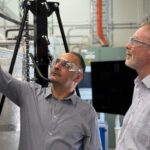Curtin researchers have found that cataract surgery not only improves impaired vision, but also significantly reduces motor vehicle accidents, which could result in a cost saving of $4.3 million over ten years.
Associate Professor Lynn Meuleners, from Curtin-Monash Accident Research Centre (C-MARC) and colleagues at the School of Public Health at Curtin University assessed car accident rates for 27,287 West Australian residents before and after cataract surgery on the first eye between 1997 and 2006. Of the study group 1,715 were involved in 1,762 accidents.
“We found that cataract surgery reduced the risk of all crashes by nearly 13 per cent,” Associate Professor Meuleners said.
“This corresponds to a cost saving of $4.3 million.”
Cataract is when the eye’s lens becomes clouded and hardened, causing impaired vision. This is very common in older people. By age 60, many have some lens opacity, and by 70 nearly all have cataract in one or both eyes.
In Australia, it is fairly common for patients to experience a delay of weeks or months between diagnosis and removal of the cataract. As such, those with cataract may continue to drive with impaired vision.
Of the study group, 1715 had a crash. The majority of patients involved in crashes were males aged between 70 and 79 who lived in metropolitan areas. Crashes included not only fatal and hospitalisation crashes, but also injury and property damage crashes.
“This study indicates that there is a real benefit to reduce waiting times for cataract surgery – not only to improve the quality of patients’ lives, but also to reduce motor accidents, and thus improve public safety, and reduce healthcare and property damage costs,” she said.
The findings are important for policy development to further improve driving outcomes among older drivers.
“Further research should be directed at assessing the impact and benefits of both first and second eye cataract surgery on crash involvement,” Associate Professor Meuleners said.
“In WA, patients on public waiting lists can wait six months for their second eye treatment and it is thus of interest to investigate the differences in crash risk after the second eye surgery.”
Contacts:
Associate Professor Lynn Meuleners, C-MARC, School of Public Health, Curtin University
Tel: 08 9266 4636, Email: l.meuleners@curtin.edu.au
Teresa Belcher, Public Relations, Curtin University
Tel: 08 9266 9085, Email: teresa.belcher@curtin.edu.au
Web: http://curtin.edu.au


